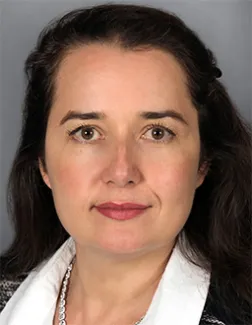

Information
Related Research Units
Research Overview
Within the newly established Rosamund Stone Translational Neuroscience Center, Dr. Makhortova is an Assistant Director of Human Neurons Core. She manages iPSC-based phenotypic assays in human neurons to uncover the mechanisms of neurodevelopmental and neuropsychiatric disorders in children and establish novel drug targets and therapeutics. She provides her expertise on image acquisition using high-content and high-throughput microscopy and handles HNCs data analysis using algorithm-based scriptwriting. She also provides instructions and training on instrument use and data analysis for BCH and industry researchers, overseeing and training HNC research assistants and users, and participating in RZ-TNC collaborations, fundraising, and marketing efforts.
Research Background
Dr. Nina Makhortova received her MD from Russian National Research Medical University in 2003 and a Ph.D. from Moscow State University in 2008. She performed her Masters's and Ph.D. projects as part of an exchange program between 2002-2008 in Philadelphia at Fox Chace Cancer Center, focusing on viral trans-synaptic transmission and CNS immune response mechanisms. Her subsequent experience comprises 10 years of work at the Translational Therapeutic Screening Center at the Harvard Stem Cell Institute in the Department of Stem Cell and Regenerative Biology. Using patient iPSC-derived 2D and 3D cellular model systems for neurodegenerative disorders, she performed high-content image-based small molecule screens in collaboration with disease foundations and industry partners. Dr. Makhortova led multiple drug discovery and cellular biomarker identification studies, including spinal muscular atrophy (SMA), amyotrophic lateral sclerosis (ALS), and diabetes type II, to discover personalized medicine approaches.
In 2019 she joined the Translational Neuroscience Center at Boston Children's Hospital in the role of Scientific Project Manager, where she helped leverage TNC operations and fundraising efforts.
Publications
- Excitatory Cortical Neurons from CDKL5 Deficiency Disorder Patient-Derived Organoids Show Early Hyperexcitability Not Identified in Neurogenin2 Induced Neurons. bioRxiv. 2024 Nov 11. View Abstract
- A Hybrid 2D-to-3D in vitro Differentiation Platform Improves Outcomes of Cerebral Cortical Organoid Generation in hiPSCs. Curr Protoc. 2024 Oct; 4(10):e70022. View Abstract
- Combining Off-flow, a Nextflow-coded program, and whole genome sequencing reveals unintended genetic variation in CRISPR/Cas-edited iPSCs. Comput Struct Biotechnol J. 2024 Dec; 23:638-647. View Abstract
- A Robust Pipeline for the Multi-Stage Accelerated Differentiation of Functional 3D Cortical Organoids from Human Pluripotent Stem Cells. Curr Protoc. 2023 Jan; 3(1):e641. View Abstract
- 16p13.11 deletion variants associated with neuropsychiatric disorders cause morphological and synaptic changes in induced pluripotent stem cell-derived neurons. Front Psychiatry. 2022; 13:924956. View Abstract
- Dynamic 3D Combinatorial Generation of hPSC-Derived Neuromesodermal Organoids With Diverse Regional and Cellular Identities. Curr Protoc. 2022 Oct; 2(10):e568. View Abstract
- Applying Deep Neural Network Analysis to High-Content Image-Based Assays. SLAS Discov. 2019 09; 24(8):829-841. View Abstract
- Systemic nature of spinal muscular atrophy revealed by studying insurance claims. PLoS One. 2019; 14(3):e0213680. View Abstract
- Single-Cell Analysis of SMN Reveals Its Broader Role in Neuromuscular Disease. Cell Rep. 2017 02 07; 18(6):1484-1498. View Abstract
- Identification of a Maleimide-Based Glycogen Synthase Kinase-3 (GSK-3) Inhibitor, BIP-135, that Prolongs the Median Survival Time of ?7 SMA KO Mouse Model of Spinal Muscular Atrophy. ACS Chem Neurosci. 2012 Jan 18; 3(1):5-11. View Abstract
- A screen for regulators of survival of motor neuron protein levels. Nat Chem Biol. 2011 Jun 19; 7(8):544-52. View Abstract
- Neurokinin-1 enables measles virus trans-synaptic spread in neurons. Virology. 2007 May 25; 362(1):235-44. View Abstract
- [Receptor-independent spread of measles virus is unique to neurons, and involves fusion of synaptic membranes]. Mol Biol (Mosk). 2007 Jan-Feb; 41(1):186-8. View Abstract